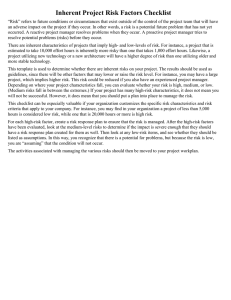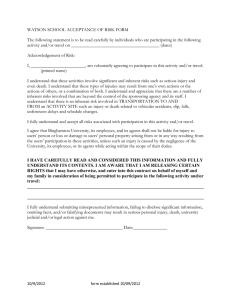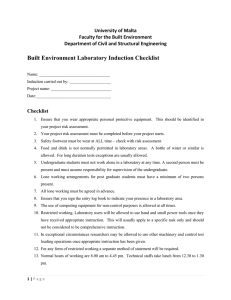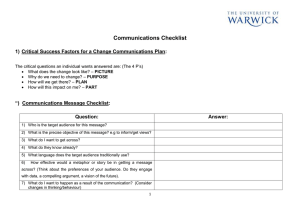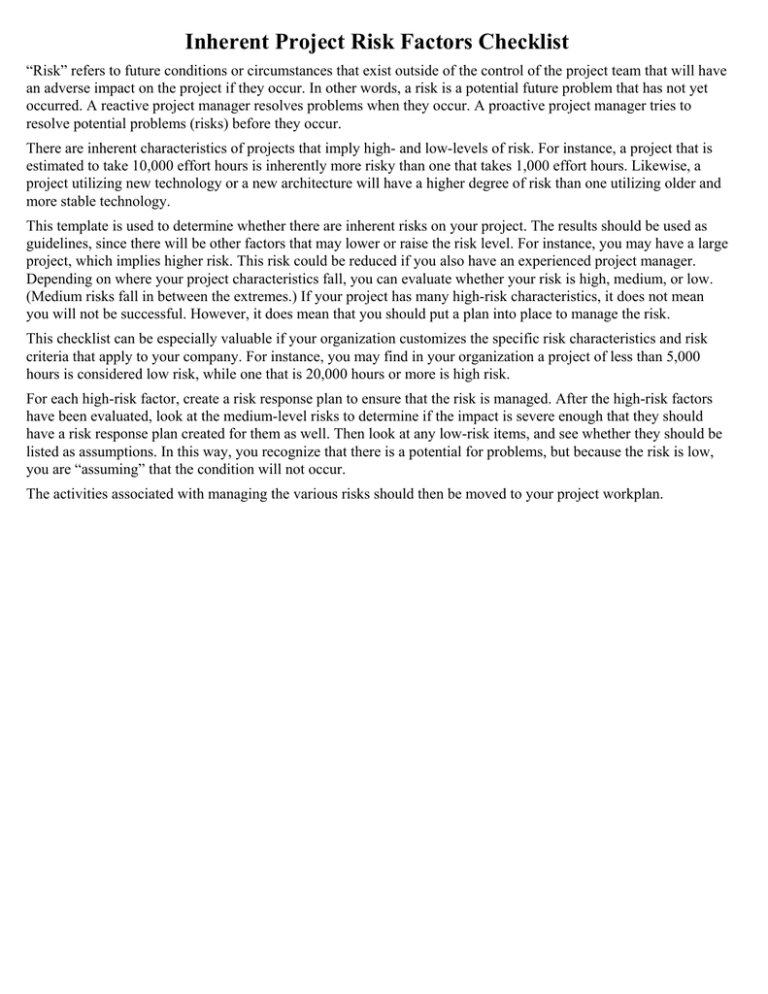
Inherent Project Risk Factors Checklist
“Risk” refers to future conditions or circumstances that exist outside of the control of the project team that will have
an adverse impact on the project if they occur. In other words, a risk is a potential future problem that has not yet
occurred. A reactive project manager resolves problems when they occur. A proactive project manager tries to
resolve potential problems (risks) before they occur.
There are inherent characteristics of projects that imply high- and low-levels of risk. For instance, a project that is
estimated to take 10,000 effort hours is inherently more risky than one that takes 1,000 effort hours. Likewise, a
project utilizing new technology or a new architecture will have a higher degree of risk than one utilizing older and
more stable technology.
This template is used to determine whether there are inherent risks on your project. The results should be used as
guidelines, since there will be other factors that may lower or raise the risk level. For instance, you may have a large
project, which implies higher risk. This risk could be reduced if you also have an experienced project manager.
Depending on where your project characteristics fall, you can evaluate whether your risk is high, medium, or low.
(Medium risks fall in between the extremes.) If your project has many high-risk characteristics, it does not mean
you will not be successful. However, it does mean that you should put a plan into place to manage the risk.
This checklist can be especially valuable if your organization customizes the specific risk characteristics and risk
criteria that apply to your company. For instance, you may find in your organization a project of less than 5,000
hours is considered low risk, while one that is 20,000 hours or more is high risk.
For each high-risk factor, create a risk response plan to ensure that the risk is managed. After the high-risk factors
have been evaluated, look at the medium-level risks to determine if the impact is severe enough that they should
have a risk response plan created for them as well. Then look at any low-risk items, and see whether they should be
listed as assumptions. In this way, you recognize that there is a potential for problems, but because the risk is low,
you are “assuming” that the condition will not occur.
The activities associated with managing the various risks should then be moved to your project workplan.
Inherent Project Risk Factors Checklist
Characteristics
Low Risk
Medium
Risk
High Risk
The business benefit of the project is:
Well defined
Poorly defined
The scope of the project is:
Well defined
Poorly defined
The project sponsor is:
Identified, committed, and enthusiastic
Not identified or not enthusiastic
The business customer commitment level is:
Passionate and enthusiastic
Passive and hard to engage
The project manager has:
Similar experience on multiple projects
Little experience on similar projects
The project team is:
Located at one site
Dispersed at multiple sites
Project management processes and procedures are:
Familiar and will be utilized
Not familiar and will not be utilized
The business requirements of the project are:
Understood and straightforward
Very vague or very complex
The system availability requirements include:
Windows of availability and downtime
Available on a 24×7 basis
The technical requirements are:
Similar to others in the company
New and complex
The data requirements are:
Simple
Complex
The number of locations to deploy to is:
One
More than four
The number of system interfaces are:
One or none
More than five
The number of organizations this will impact is:
One or two
More than five
The total estimated effort hours are:
Less than 1,000 hours
Greater than 5,000 hours
The total estimated project duration is:
Less than three months
Longer than one year
The subject matter is:
Well known by the project team
Not well known by the project team
The project is dependent on:
Zero or one outside project or team
Three or more outside teams or projects
Business processes, procedures, policies require:
Little or no change
Substantial change
Changes to the organizational structure require:
Little or no change
Substantial change
The technology being utilized consists of:
The quality of current data is:
If a package implementation:
Existing software, hardware, languages,
databases, and tools.
New software, hardware, languages, databases,
or tools (or new releases)
Well defined and simple to convert
Poor or complex to convert
No (or minimal) customization needed
Heavy customization needed
Stable product or release
Product or release that is new to the market
Vendor familiar in this market
Vendor new to this market
2
Copyright© 2000–2003 TenStep, Inc. All Rights Reserved

